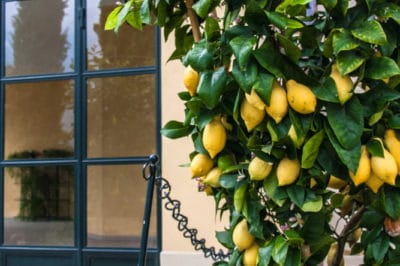The Best Lemon Trees for Potting
Three lemon tree cultivars –‘Meyer,’ ‘Eureka,’ and ‘Eureka Variegated Pink’ are proven performers as potted plants. The first two reach 8 to 10 feet tall and the third from 12 to 15 feet. ‘Meyer’ is notable for sweet, easy-to-peel lemons. ‘Eureka Variegated Pink’ boasts ivory-edged leaves and pink-pulped fruit.
Picking Your Pot
Start with a pot one size larger than your tree’s nursery container, made of lightweight, moisture-retaining plastic or polypropylene. Choose one with multiple drainage holes. Stay away from a heat-absorbing black one; it could damage the roots.
Set your pot in a plastic drainage saucer that you’ll empty right after watering. If you anticipate moving it, treat yourself to a plant caddy or a caster-equipped planter.
Expert gardener’s tip: Indoor lemon trees are much happier if they’re moved outside for the summer.
Potting Mix
Pot your tree in a good commercial citrus potting mix, or make your own containing equal parts of:
- Sand
- Bark
- Peat moss
Before transplanting, moisten the mix thoroughly.
Watering
An underwatered lemon tree’s leaves will dry out and curl. An overwatered one’s will be cupped and yellow. To avoid both, water only when the potting mix feels and looks very dry. Water should drain from the holes and the pot should be noticeably heavier when you’re done.
Fertilizing
Keep root-burning mineral salts from building up in the pot with an organic, slow-release fertilizer supplemented with trace minerals. Look for a formula with a 2-1-1 or 3-1-1 ratio of nitrogen to phosphorous and potassium. Always apply it at the label’s recommended rate and frequency for the size of your pot.
Cold Protection
To protect your potted lemon tree from cold damage in USDA zones 9 through 11, don’t prune or fertilize it any later than June. When the temperature is expected to drop below 33° F (0.55°C), either cover it with a frost cloth or move it to a garage or other sheltered location.
If your tree spends the summer outside, bring it indoors as soon as the temperature is consistently below 55°F (12.7°C). While it’s inside, keep it away from both hot and cold drafts.
